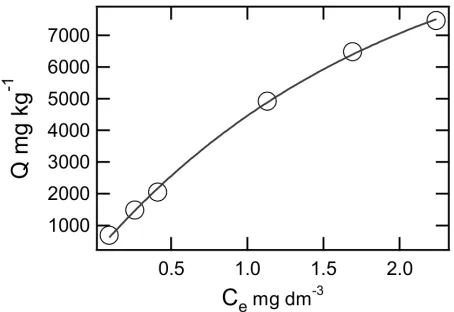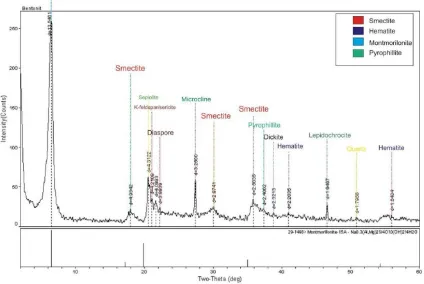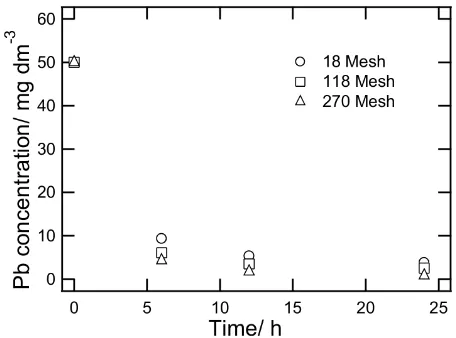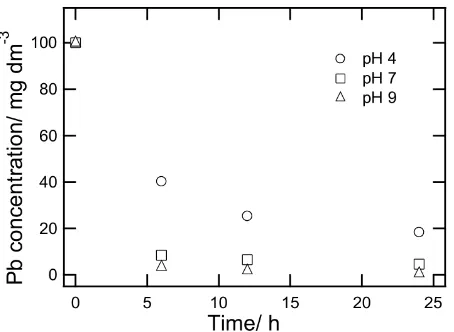REMOVAL OF LEAD (Pb
2
+
) FROM AQUEOUS
SOLUTIONS BY NATURAL BENTONITE
Wahyu Wilopo∗1, Doni Prakasa Eka Putra1, I Wayan Warmada1, and Tsuyoshi Hirajima2
1Department of Geological Engineering, Gadjah Mada University, Yogyakarta, Indonesia 2Earth Resources Engineering Department, Kyushu University, Japan
Abstract
The aim of the present work is to investigate the abil-ity of natural bentonite (untreated) from Pacitan, East Java to remove lead ions from aqueous solution. The bentonite has specific surface area and cation ex-change capacity of 27.52 m2g−1and 65.20 meq/100 gr of bentonite, respectively. Towards this aim, batch adsorption experiments were carried out and the ef-fect of various parameters on this removal process has been investigated. The effects of pH, grain size of bentonite, adsorption time and lead ion concentra-tion on the adsorpconcentra-tion process were examined. The optimum pH for adsorption was found to be 9, with the finer grain size of bentonite is more effective. In adsorption studies, residual lead ions concentration reached equilibrium in a duration of 24 hours. Ad-sorption of lead on bentonite appeared to follow Fre-undlich isotherm. Our results demonstrate that the adsorption process was mostly dominated by ion ex-change process.
Keywords:Removal, lead, aqueous solution, natu-ral bentonite, adsorption.
1 Introduction
The removal of metal ions from wastewaters by different adsorbents is always of great chal-lenge (Emin and Dursun, 2008). Almost all of wastewaters contain considerable amounts of metal ions that would be harmful for public health and the environment if discharged
with-∗Corresponding author: W. WILOPO, Department of Geological Engineering, Faculty of Engineering, Gadjah Mada University, Jl. Grafika 2 Yogyakarta, 55281, Indone-sia. E-mail: wwilopo@gadjahmada.edu
out treatment. High concentrations of the met-als in water affect humans, animmet-als and veg-etation. The pollution of water and soil with heavy metals ion increases proportionally with the expansion of industrial activities (Aydinet al, 2008). In order to minimize a treatment costs for the industrial wastewaters, most of the last investigations have focused on the use of low cost adsorbents (Meenaet al, 2008).
In the last decade, utilization of geologic ma-terial as adsorbent is more applicable (Wilopo et al, 2012; Wilopo et al, 2011; Wilopo et al, 2010). One of geologic materials is clay miner-als which applied to control the pollution due to the effluents polluted with heavy metal ions. Bentonite is one type of clay minerals which has ion-exchange capability to remove unwanted metal ions and this property makes bentonite favorable for wastewater treatment. There-fore, bentonite clay has been studied as ion ex-changer and/or adsorbent due to its framework (Sajidu et al, 2008). Beside this, price of ben-tonite is considered very cheap and easy to find in our surrounding area (Zhuet al, 2007). The objective of this research is to evaluate the ca-pability of bentonite from Pacitan, East Java for removing of lead from aqueous solution.
2 Experimental
2.1 Material
tween the layer sheets, involving an underes-timation of specific surface areas (D´ek´any and Nagy, 1991). Cation exchange capacity (CEC) of bentonite value is 65,20 meq/100 gr bentonite without any pretreatment. Based on the XRD (Figure 1) of bentonite consist montmorilonite, smectite and hematite. The composition of el-ements in bentonite was characterized using XRF shown the dominant elements consist of Al (9.3 wt.%), Fe (4.88 wt.%), Ca (2.05 wt.%) and Mg (1.7 wt.%). Therefore, bentonite from Paci-tan is categorized as Ca-Mg bentonite (Meunier, 2003).
2.2 Batch Experiments
Several batch tests were performed to deter-mine the capability of bentonite to remove Pb2+ in solution. Five grams of bentonite was used to find the sorption isotherm of Pb onto ben-tonite using 0.25 dm−3solutions containing dif-ferent concentrations of Pb2+with initial pH 7.
The pH of the solution was adjusted by using a dilute NaOH and HCl solutions. All solutions of Pb2+were prepared using PbO special grade
from Merck KGaA Germany. All solutions were shaken at 120 rpm and 25◦C until sorption equi-librium was attained. Lead concentration was determined by Atomic Absorption Spectropho-tometer (AAS).
3 Result and Discussion
The raw data for sorption isotherm of Pb2+ onto Bentonite at 25◦C was presented in Fig-ure 4a. It shows that the sorption equilibrium was achieved after 24 hour. The equilibrium pHs of the solutions from bentonite are 7.9–8.2, all of them are higher than the initial pH as
Figure 3: Adsorption isotherm of Cu2+ ion on lignite.
shown in Figure 4b). As can be seen from this figure, increase in the final suspension pH af-ter lead adsorption may be attributed to the re-placement of alkaline and alkaline earth metals (Na+, K+, Ca2+, Mg2+) located in the exchange sites of bentonite with lead ions existed in the solutions.
Adsorption isotherm for lead on the ben-tonite is presented in Figure 3. This isotherm is generally L type according to the Giles Clas-sification. Type L represents the Langmurian adsorption isotherm, which is characteristic for strong chemical reaction. To quantify the ad-sorption capacity of lignite in relation to the lead ion, the experimental data were fitted to the Langmuir linear equation:
C/Qe=1/(b Qmax) +C/Qmax (1)
and Freundlich nonlinear and linear equa-tions:
Q=Kf C1/n (2)
q=logKf +1/n logC (3)
Figure 1: X-ray diffraction analysis of Bentonite showing the presence of montmorilonite, smectite and hematite.
Figure ??a shows the straight lines of Lang-muir isotherm obtained plotting C/Qe versus Ce for lead on bentonite samples studied, cor-relation coefficients being in this cases greater than 0.94. Qmax and bparameters were calcu-lated from the least squares method applied to the straight lines in Figure??a. The Langmuir characteristic parameters and the degree of cor-relation of the adsorption data with respect to this equation are given in Table 1. Figure ??b shows the Fruendlich isotherm with their pa-rameters in Table 1. The degree of correlation of Fruendlich isotherm is better than Langmuir isotherm, it means that this reaction more favor-able to follow the Fruendlich assumption.
Analysis of cations concentration before the experiment and after reach the equilibrium shows that mostly of cations concentration after reach the equilibrium were higher than before the experiment especially for Calcium (Table 22). This data indicate that the mecha-nism of lead removal onto bentonite not only by physical sorption due to high surface area but also mostly by cation exchange process with calcium.
The effect of grain size was also studied us-ing bentonite with mesh number 18, 115 and 270. It shows that the bentonite with fine grain size (mesh 115) is more effective than coarse grain size due to increase of surface of
ben-Figure 5: The effect of grain size in the Pb re-moval by bentonite.
tonite. Therefore lead solution is easier to react with bentonite surface as shown in Figure 5.
The pH dependence of Pb2+ sorption onto Bentonite is shown in Figure 6. Experiments were carried out using Pb2+ion concentrations
100 mg dm−3 at different pH values. As it is seen in Figure ??, adsorbed amount of lead is low at low pH values. The value of ad-sorbed amount of lead is increased by increas-ing the pH value. It is apparent that usincreas-ing solu-tions at pH values 9 gives the highest adsorbed amount of lead values. The surface charge of bentonite is a strong function of the pH. There-fore at low pH, the exchange sites on the ben-tonite particle become positive, the lead cations compete with the H+ ions in the solution for the active sites and consequently lower adsorp-tion (Srivastava et al, 2006). At high pH val-ues, surface of the bentonite has a higher nega-tive charge which results in higher attraction of Pb2+cations. These data are in agreement with the results obtained by several earlier work-ers for metal adsorption on different adsorbent (Bhattacharyaet al, 2006; Chakiret al, 2002)
4 Conclusions
The Pacitan bentonite has characteristic with specific surface area and cation exchange capac-ity of 27.52 m2 g−1 and 65.20 meq/100 gr of
Figure 4: (a) The langmuir isotherms of Pb2+ion on bentonite; (b) The Fruendlich isotherm of Pb2+
ion on bentonite.
Figure 6: Removal of lead in the different of pH solution.
of lead. The adsorption isotherm analysis was favorable to follow the Freundlich isotherms for single metal system. The maximum lead removal was estimated 5 g kg−1 of bentonite according to the Langmuir equation. Smaller grain size of bentonite and high pH of lead so-lution makes more effective of lead removal by bentonite. The mechanism of lead removal onto bentonite is mainly by cations exchange pro-cess.
Acknowledgement
The authors would like to thanks for AUN-SEED/Net for providing a financial supports by Special Research Program for Alumni Mem-bers.
References
Aydin, H., Bulut, Y. and Yerlikaya, C. (2008) Re-moval of Copper (II) from Aqueous Solution by Adsorption onto Low-cost Adsorbents, Journal of Environmental Management 87: 37–45.
Bhattacharya, A.K., Mandal, S.N. and Das, S.K. (2006) Adsorption of Zn(II) from Aqueous Solu-tion by using Different Adsorbents, Chem. Eng. J. 123: 43–51.
Bourg, C.I., Sposito, G. and Bourg, A.C.M. (2007) Modeling the Acid-base Surface Chemistry of Montmorillonite, J. Coll. Interface Sci. 312: 297– 310.
Chakir, A., Bessiere, J., Kacemia, K. and Marouf, B. (2002) A Comparative Study of the Removal of Trivalent Chromium from Aqueous Solutions by Bentonite and Expanded Perlite, J. Hazard. Mater. B95: 29–46.
D´ek´any, I. and Nagy, L.G. (1991) Immersional Wetting and Adsorption Displacement on Hy-drophilic/hydrophobic Surfaces, J. Coll. Interface Sci. 147: 119–128.
Emin, E. and Dursun, S. (2008) A New Approach to Modification of Natural Adsorbent for Heavy Metal Adsorption, Bioresource Technology 99: 2516–2527.
Goldberg, S. (2002) Competitive Adsorption of Ar-senate and Arsenite on Oxides and Clay Minerals. Soil Sci. Soc. Am. J. 66: 413–421.
Hillel, D. (1998) Environmental Soil Physics, Aca-demic Press, New York.
Meena, A.K., Kadirvelu, K., Mishra, G.K., Ra-jagopal, Chitra and Nagar, P.N. (2008) Adsorptive Removal of Heavy Metals from Aqueous Solution by Treated Sawdust (Acacia arabica), J. Hazard. Mater 150: 604–611.
Central Kalimantan, Journal of Southeast Asian Applied Geology 3: 125–128.
Wilopo, W., Haryono, S.N., Putra, D.P.E, Warmada, I W. (2010) Copper (Cu2+) removal from wa-ter using natural zeolite from Gedangsari,



